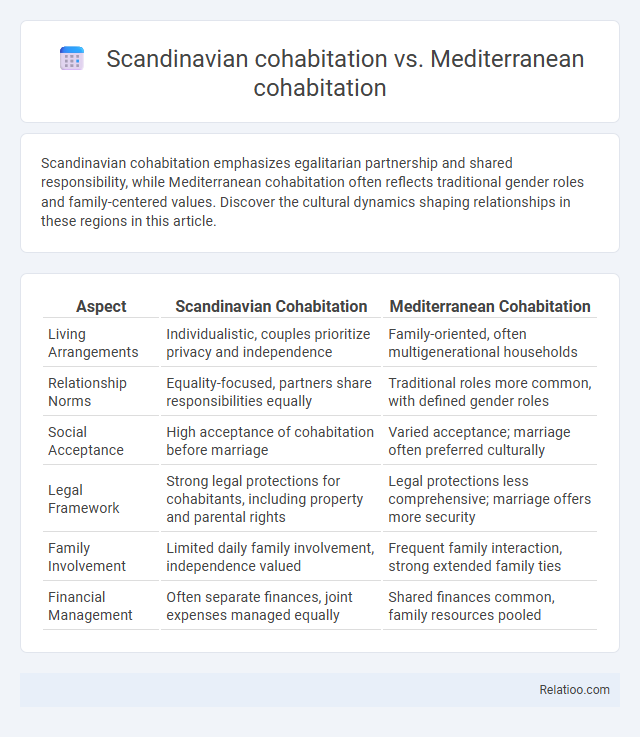Scandinavian cohabitation emphasizes egalitarian partnership and shared responsibility, while Mediterranean cohabitation often reflects traditional gender roles and family-centered values. Discover the cultural dynamics shaping relationships in these regions in this article.
Table of Comparison
| Aspect | Scandinavian Cohabitation | Mediterranean Cohabitation |
|---|---|---|
| Living Arrangements | Individualistic, couples prioritize privacy and independence | Family-oriented, often multigenerational households |
| Relationship Norms | Equality-focused, partners share responsibilities equally | Traditional roles more common, with defined gender roles |
| Social Acceptance | High acceptance of cohabitation before marriage | Varied acceptance; marriage often preferred culturally |
| Legal Framework | Strong legal protections for cohabitants, including property and parental rights | Legal protections less comprehensive; marriage offers more security |
| Family Involvement | Limited daily family involvement, independence valued | Frequent family interaction, strong extended family ties |
| Financial Management | Often separate finances, joint expenses managed equally | Shared finances common, family resources pooled |
Introduction to Cohabitation Trends in Europe
Cohabitation trends in Europe reveal distinctive patterns between Scandinavian and Mediterranean regions, shaped by cultural, social, and legal factors. Scandinavian countries, known for progressive social policies, exhibit higher rates of cohabitation and more acceptance of non-marital unions, while Mediterranean countries tend to emphasize traditional family structures and lower cohabitation prevalence. Your understanding of these regional differences can inform perspectives on family dynamics and evolving social norms across the continent.
Defining Scandinavian and Mediterranean Cohabitation
Scandinavian cohabitation is characterized by long-term, committed relationships often resembling marriage, supported by progressive social policies and widespread acceptance. Mediterranean cohabitation tends to be less common and often viewed as a transitional phase before marriage, influenced by strong cultural and religious traditions emphasizing formal unions. Cohabitation generally refers to unmarried partners living together, but its social acceptance and legal recognition vary significantly between Scandinavia's egalitarian societies and the Mediterranean's traditional family structures.
Historical Evolution of Cohabitation Norms
Scandinavian cohabitation has evolved through progressive social policies and widespread acceptance since the mid-20th century, emphasizing gender equality and individual autonomy. Mediterranean cohabitation norms historically emphasized traditional marriage, with cohabitation often stigmatized until recent decades when social and economic changes fostered gradual acceptance. Your understanding of cohabitation benefits from recognizing these regional differences shaped by cultural, religious, and legal influences over time.
Legal Frameworks and Rights for Unmarried Partners
Scandinavian countries such as Sweden and Norway implement comprehensive legal frameworks granting unmarried partners rights akin to married couples, including property division and parental responsibilities. In contrast, Mediterranean nations like Italy and Spain generally offer limited protections, often requiring formal agreements or cohabitation registrations to secure rights related to inheritance or social benefits. Cohabitation laws vary widely, with Northern European models emphasizing statutory recognition and Mediterranean systems relying more on contractual arrangements to protect partners legally.
Cultural Attitudes Toward Cohabitation
Scandinavian cohabitation reflects a cultural acceptance rooted in progressive social policies and high gender equality, where living together without marriage is normalized and legally recognized. Mediterranean cohabitation, influenced by traditional Catholic values, tends to emphasize marriage over cohabitation, often viewing the latter as less socially acceptable or temporary. Cohabitation trends globally reveal diverse cultural attitudes, with northern European countries showing greater acceptance and legal protections compared to conservative Mediterranean regions where family and religious norms heavily influence social perceptions.
Religious Influences on Living Arrangements
Scandinavian cohabitation often reflects secular values, with a strong emphasis on individual freedom and gender equality, resulting in widespread acceptance of living together without marriage. Mediterranean cohabitation remains heavily influenced by Catholicism, where traditional family structures and marriage are emphasized, often discouraging cohabitation before marriage. Your choice to cohabit in these regions may be shaped by the prevailing religious norms, which significantly impact social acceptance and legal recognition of unmarried couples.
Family Structures and Parenting in Cohabiting Households
Scandinavian cohabitation typically features egalitarian family structures with shared parenting responsibilities and strong social support systems, promoting gender equality. Mediterranean cohabitation often aligns with traditional gender roles, where extended family networks play a significant role in child-rearing and household dynamics. Cohabiting households overall show diverse parenting models influenced by cultural norms, economic factors, and welfare policies, with Scandinavian models emphasizing institutional support and Mediterranean models relying more on familial ties.
Socioeconomic Factors Impacting Cohabitation
Scandinavian cohabitation is strongly influenced by comprehensive welfare systems and gender-equal policies that promote stable unions without marriage, reflecting high female labor force participation and extensive social benefits. In contrast, Mediterranean cohabitation is less common and often shaped by traditional family values, lower social acceptance, and economic instability, resulting in a preference for marriage as economic security. Overall, socioeconomic factors such as income level, employment stability, social welfare access, and cultural norms critically shape cohabitation patterns across these regions.
Cohabitation and Social Stigma: North vs. South
Cohabitation rates are significantly higher in Scandinavian countries, where social stigma around living together without marriage is minimal due to progressive cultural norms and strong social welfare systems. In contrast, Mediterranean countries exhibit lower cohabitation rates and persistent social stigma rooted in traditional family values and religious influences, which emphasize marriage as a social and legal institution. The North-South divide highlights how cultural acceptance and policy frameworks shape the prevalence of cohabitation and societal attitudes toward non-marital partnerships.
Future Outlook: Changing Patterns and Influences
Scandinavian cohabitation trends emphasize gender equality and legal recognition, shaping a future where Your partnerships may gain increased social and economic benefits. Mediterranean cohabitation remains influenced by traditional family structures and religious values, yet gradual shifts toward acceptance and legal reforms are emerging. Cohabitation patterns globally show growing diversity, suggesting changes in legal frameworks and cultural attitudes will continue to influence how partners choose to live together.

Infographic: Scandinavian cohabitation vs Mediterranean cohabitation
 relatioo.com
relatioo.com